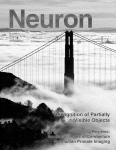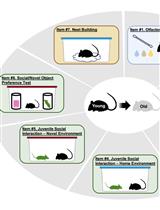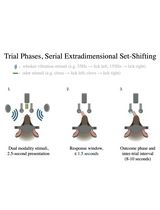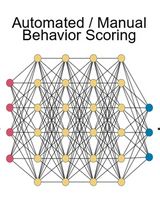- EN - English
- CN - 中文
Assessment of Olfactory Behavior in Mice: Odorant Detection and Habituation-Dishabituation Tests
小鼠嗅觉行为的评估;气味检测以及习惯化与去习惯化测试
发布: 2015年07月05日第5卷第13期 DOI: 10.21769/BioProtoc.1518 浏览次数: 13082
评审: Soyun KimYatang LiAnonymous reviewer(s)
Abstract
Olfaction has adaptive value for rodents as it is essential for feeding and mating, the establishment of social and territorial relationships, or the detection of potential predators, among others (Apfelbach et al., 2005). Sensory input from the olfactory mucosa is first processed in the main olfactory bulb (MOB), a telencephalic structure that exhibits neurogenesis during the lifespan of the animal. Changes in MOB circuitry due to neuronal dysfunction or changes in interneuron turnover rate affect olfactory performance in different ways (Fleming et al., 2008; Breton-Provencher et al., 2009; Attems et al., 2014). Alterations in adult MOB neurogenesis, in particular, result in changes in odorant discrimination which can be assayed in habituation-dishabituation behavioral paradigms (Mouret et al., 2009; Delgado et al., 2014). Here, we present a simple protocol for the quantitative assessment of two olfactory tasks that can be used to detect neurogenic alterations in the MOB (Delgado et al., 2014). The procedure has been optimized to require little time and can, therefore, be used to analyze genetically modified mice that are housed in an isolated specific pathogen-free (SPF) mouse facility.
Materials and Reagents
- Animals
Laboratory-bred experimentally-naïve male mice. Both CD1 and C57BL/6J strains have been successfully tested. Male mice are housed in groups of 4-5 per cage, kept in an environment with controlled temperature (23 ± 2 °C) and humidity under a 12-12 h light-dark cycle with food and water ad libitum. The use of only one gender reduces inter-individual variation. Males are used instead of females to avoid cycling hormone effects associated to oestrus (Jemiolo et al., 1986).
Note: All mice must be of equal or similar age (i.e. always less than two weeks apart, as the rate of neurogenesis is age-dependent). When this is not possible, cohorts of similar sizes for each experimental condition can be tested separately at different times, but this schedule results in greater variability and will, therefore, require a higher total number of animals. In most of our experiments a minimum of 7 mice were required to reach statistical significance. However, 10-12 mice per group are recommended to minimize the effects of inter-individual variation. - Odorants
Odorants must have non-emotional value. We use two synthetic odorants: citralva (geranonitrile, 3,7-dimethyl-2,6-octadien-1-nitrile), a lemon-like citrus smell, and geraniol (3,7-dimethyl-2,6-octadien-1-ol), a sweet rose-like scent, at dilutions that range between 1:160 to 1:10. Both odorants have been tested before in olfactory experiments (Luo et al., 2002; Delgado et al., 2014) although others, i.e. banana odor (isoamyl acetate), almond odor (benzaldehyde), or hexanal, have also been used in similar tests (see, for example, Mandairon et al., 2006; Fleming et al., 2008). Odorants can be obtained from different suppliers, such as Ventós S.A (dealer of International Flavors and Fragrances Inc. Barcelona, Spain). Because synthetic fragrances are usually available in an oleic format, we use mineral oil for their dilution. It is important to keep them always in tightly sealed containers to minimize their evaporation. - Other materials
1.Mineral oil (Sigma-Aldrich, catalog number: M5904 )
Equipment
Olfactory experiments are performed in a dedicated lab room with positive pressure (10-15 gauges) and frequent air reposition (no less than 20 times per hour) for fast removal of odors. Indirect dim lighting is recommended for testing. Essence dilutions should be prepared in a different, not connected room.
The materials used (see Figure 1) are:
- A 22.5 x 22.5 x 29.5 cm open Plexiglas box with solid light green walls and a hole of 1 cm of diameter in one of the sides, located at 8 cm above the box ground and at 11.2 cm from the lateral corners of the box. A transparent methyl methacrylate solid cover is advisable to avoid essence dissipation during the tests. The video recording system is fixed above the exploration box at a distance of 30-40 cm from the transparent cover in order to video-tape at good resolution without interfering with the test.
Note: The olfactory exploration box can be custom-made following the description. The box is thoroughly wiped clean with 10% alcohol and dried before and after the experiment, as well as between animals. After each test, the used soiled bedding has to be carefully removed with a household vacuum cleaner and replaced by fresh bedding. Use odorless disposable paper towels and nitrile gloves for cleaning and drying. - Regular cotton sticks bought in any drugstore
- Lab timer
- Micropipette (2-20 or 20-200 µl-range) and appropriate disposable tips
- Adhesive tape
- 1.5 ml microcentrifuge tubes to preserve the essences and a microcentrifuge tube rack to avoid fluid-containing tubes from tipping over
- A sealed container (optional if the garbage bag is sealed) can be used for disposal of any objects that are impregnated with essences.
Procedure
文章信息
版权信息
© 2015 The Authors; exclusive licensee Bio-protocol LLC.
如何引用
Perez-Villalba, A., Palop, M. J., Pérez-Sánchez, F. and Fariñas, I. (2015). Assessment of Olfactory Behavior in Mice: Odorant Detection and Habituation-Dishabituation Tests. Bio-protocol 5(13): e1518. DOI: 10.21769/BioProtoc.1518.
分类
神经科学 > 行为神经科学 > 认知
神经科学 > 行为神经科学 > 学习和记忆
神经科学 > 感觉和运动系统
您对这篇实验方法有问题吗?
在此处发布您的问题,我们将邀请本文作者来回答。同时,我们会将您的问题发布到Bio-protocol Exchange,以便寻求社区成员的帮助。
Share
Bluesky
X
Copy link












